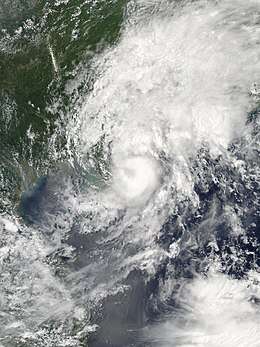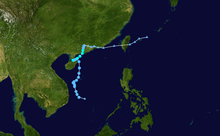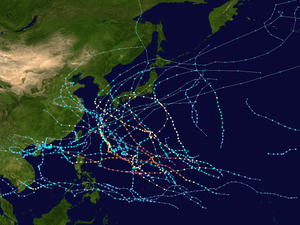Tropical Storm Ewiniar (2018)
Tropical Storm Ewiniar was a tropical cyclone in early June 2018 that brought prolonged heavy rains to Vietnam and South China, causing damaging floods and landslides. The fourth named storm of the 2018 Pacific typhoon season, Ewiniar developed as a tropical depression just east of Vietnam on June 2. The system moved generally northwards over the South China Sea, before intensifying into a tropical storm near the Qiongzhou Strait on June 5. Ewiniar proceeded to stall over the region as steering currents collapsed, making landfall over the Leizhou Peninsula then over northern Hainan. Ewiniar accelerated to the northeast on June 7 and moved back over open sea, allowing it to strengthen slightly and reach peak intensity. The storm made landfall in eastern Guangdong shortly thereafter and weakened into a tropical depression on June 8. The system ultimately dissipated east of Taiwan on June 11.
| Tropical storm (JMA scale) | |
|---|---|
| Tropical storm (SSHWS) | |
 Tropical Storm Ewiniar shortly before landfall and peak strength on June 7 | |
| Formed | June 2, 2018 |
| Dissipated | June 11, 2018 |
| Highest winds | 10-minute sustained: 75 km/h (45 mph) 1-minute sustained: 75 km/h (45 mph) |
| Lowest pressure | 998 hPa (mbar); 29.47 inHg |
| Fatalities | 14 total |
| Damage | $749 million (2018 USD) |
| Areas affected | Philippines, Vietnam, South China, Taiwan, Ryukyu Islands |
| Part of the 2018 Pacific typhoon season | |
In combination with the southwest monsoon, Ewiniar dumped heavy rain over Vietnam and South China for over a week. In Vietnam, a few houses were damaged and one person was killed. Roads in Ho Chi Minh City were inundated. In Hainan and Guangdong, over a hundred flights were cancelled and ships were forced to take shelter. Daily rainfall records for June were set in eight cities. Twenty-nine houses were destroyed and over 27,000 hectares (67,000 acres) of crops were damaged. Landslides killed five people in Yunfu and left one missing in Jiangmen. Strong winds blew down a construction site in Guangzhou, killing one and injuring eight, and caused a building collapse in Shenzhen that killed four and injured four others. Another two people were electrocuted by faulty wiring. A tornado occurred in Foshan, damaging a market and three vehicles. Travel disruptions also posed difficulties for students taking the National College Entrance Examination. A total of 13 people were killed in South China and direct economic losses were valued at ¥5.19 billion (US$749 million).[nb 1] In Hong Kong and Macao, strong wind signals were issued and some schools were closed. Gusty winds felled trees and heavy rains caused flash flooding, while a waterspout was sighted near Cheung Chau.
Meteorological history

Ewiniar originated from an area of scattered thunderstorms that developed just southeast of Puerto Princesa on May 31.[1] The system moved northwest and consolidated, with the Joint Typhoon Warning Center (JTWC) determining that it consolidated into a tropical depression at 12:00 UTC on June 2.[2] The Japan Meteorological Agency (JMA) followed suit six hours later, by which time the system was about 300 km (190 mi) off the coast of Vietnam.[3][nb 2] The depression, pushed northwest by a subtropical ridge to its northeast, organized only slowly amid an environment marginally conducive to intensification, with wind shear limiting convection mostly to the depression's western flank.[5] The depression changed little in strength on June 3 and 4 as it turned further north around the western edge of the aforementioned ridge,[6] eventually curving to the north-northeast on June 5. Around this time, thunderstorm activity increased in coverage with the development of outflow channels;[7] as a result, the JMA upgraded the depression to Tropical Storm Ewiniar at 00:00 UTC.[3] Wind shear decreased later on June 5, allowing Ewiniar to maintain thunderstorms near its center and intensify slightly.[8] The JTWC upgraded the system to a tropical storm at 18:00 UTC as the storm's motion slowed and turned back to the northwest.[2]
The subtropical ridge steering the storm collapsed thereafter, leaving Ewiniar in a zone of weak steering currents over the Qiongzhou Strait.[9] The system made landfall in Xuwen, Guangdong at 22:25 UTC on June 5, before turning southwest and making another landfall in Haikou, Hainan at 06:50 UTC on June 6.[10] While over the Leizhou Peninsula, the JTWC assessed that Ewiniar weakened back into a tropical depression,[2] whereas the JMA maintained the system at tropical storm intensity.[3] On June 7, Ewiniar finally began to accelerate east-northeastwards ahead of a shortwave trough. This moved Ewiniar back over water and allowed it to restrengthen,[11] reaching peak intensity with maximum sustained winds of 75 km/h (45 mph) and a minimum pressure of 998 hPa (mbar; 29.57 inHg) at 06:00 UTC.[3][2] Ewiniar then turned to the north-northeast as it began to interact with the Meiyu front,[12] before making a third landfall in Yangjiang, Guangdong at 12:30 UTC June 7.[10] Once inland, the system soon became embedded within the Meiyu front and the JTWC declared that Ewiniar dissipated as a tropical cyclone near midday on June 8.[13][2] The JMA, however, continued to track Ewiniar as a tropical depression while the system turned back east and emerged over the South China Sea on June 10. After crossing Taiwan on June 11, Ewiniar was finally declared to have dissipated by the JMA.[3]
Preparations and impact
Vietnam
Ewiniar combined with the southwest monsoon to produce thunderstorms and gusty winds over Vietnam.[14] Farmers were urged to complete the rice harvest before the onset of heavy rain.[15] Tourists were evacuated from the Chàm Islands,[16] while about 2,000 tourists were stranded on Lý Sơn Island.[17] Several roads in Ho Chi Minh City were inundated with water up to 30 cm (12 in) deep.[18] Landslides damaged three houses in Lào Cai Province and two more in Thanh Hóa Province, while floods washed away two houses in Cao Bằng Province. A person was killed in Quan Sơn District.[19]
Mainland China
Ewiniar brought heavy rain to South China and Jiangnan for seven days, affecting 211,200 people with floods and landslides. Rainfall totals exceeded 250 mm (9.8 in) over 66,000 km2 (25,000 sq mi) of land. A peak rainfall accumulation of 845 mm (33.3 in) was observed at Luotang Reservoir in Guangdong. Eight cities saw new records for highest daily rainfall in June.[10][20] In Hainan, schools were closed in the capital Haikou.[21] About 5,530 people (mostly fishermen) were moved to safety. High-speed rail services around the island were suspended and the Yuehai Ferry halted operations, while dozens of flights were cancelled at Haikou Meilan International Airport and Sanya Phoenix International Airport.[22] The Qiongzhou Strait was closed to passenger ships on June 4 and 5.[21] In Guangdong, 73,000 residents were evacuated to over 3,000 emergency shelters. At Guangzhou Baiyun International Airport, 73 outbound flights and 71 inbound flights were cancelled.[23] A total of 404 ships took shelter in the Port of Zhanjiang.[24]
The passage of Ewiniar resulted in 13 fatalities and ¥5.19 billion (US$749 million) of damage.[20] Landslides killed five people in Xinxing County[25] and caused another person in Jiangmen to go missing. Twenty-nine houses collapsed and 27,350 hectares (67,600 acres) of crops were damaged.[10] In Foshan, two women died after being electrocuted by faulty electrical wiring on a digital billboard at a bus stop.[26] Ewiniar also spawned a tornado in Dali,[27] which blew off a market's 400 m2 (4,300 sq ft) roof and damaged three cars but caused no casualties. A construction site in Nansha District collapsed under strong winds, killing one and injuring eight others.[28] Heavy rain caused the exterior of a building in Longgang District, Shenzhen to collapse, resulting in four deaths and four injuries.[29] Roads were blocked by floods in Haikou, disrupting traffic.[22] Floods occurred during the National College Entrance Examinations on June 7–8, obstructing students' travel. Police and firefighters were dispatched to examination centers to ensure students could arrive safely and on time.[26][23] In Zhaoqing, 200 students were ferried to their examination centers using trucks, dinghies, and steamboats.[30] Insured losses in Guangdong (excluding the city of Shenzhen) were approximately ¥300 million (US$47 million).[31] Authorities allocated ¥290,000 (US$45,000) of funds for disaster relief and distributed bottled water, food, tents, beds, and towels to displaced residents.[22]
Hong Kong and Macao
Ewiniar was the first tropical cyclone to affect Hong Kong in 2018. The system brought flooding rain and squalls to Hong Kong from June 5–8. Rainfall totals across the region mostly exceeded 250 mm (9.8 in); northeast parts of the New Territories recorded over 400 mm (16 in) of rain. The No. 3 Strong Wind Signal was raised over the territory from June 7–8,[32] during which kindergartens and schools for children with disabilities were closed and bunker operations at the Port of Hong Kong were suspended.[33][34] Fallen trees damaged vehicles and obstructed traffic, with one such incident in Sai Wan Ho resulting in an injury.[32] Flooding occurred in several areas in the city, with reported incidents in Kam Shan, Diamond Hill, and Man Kam To.[35] A waterspout was sighted near Cheung Chau on June 7.[36] A storm surge of 0.68 m (2.2 ft) was measured at Tsim Bei Tsui.[32] In neighboring Macao, the No. 3 Strong Wind Signal was also issued from June 7–8. Rainfall accumulations from June 6–8 reached 200 mm (7.9 in). Periods of intense rain, peaking at 46 mm (1.8 in) in one hour on the morning of June 8, caused several instances of flash flooding.[37]
See also
- Other tropical cyclones named Ewiniar
- Tropical Storm Russ (1994) – another damaging June system that brought severe flooding to South China
- Tropical Storm Hagibis (2014) – brought torrential rainfall to Guangdong in June
Notes
- All currencies are converted to United States Dollars using XE Currency Converter.
- The Japan Meteorological Agency is the official Regional Specialized Meteorological Center for the western Pacific Ocean.[4]
References
- "Significant Tropical Weather Advisory for the Western and South Pacific Oceans". Joint Typhoon Warning Center. May 31, 2018. Archived from the original on June 1, 2018. Retrieved June 12, 2020.CS1 maint: unfit url (link)
- Chu, J. H.; Levine, A.; Daida, S.; Schiber, D.; Fukada, E.; Sampson, C. R. (2019). "Western North Pacific Ocean Best Track Data 2018". Joint Typhoon Warning Center. Retrieved June 12, 2020.
- "RSMC Tropical Cyclone Best Track Name 1804 Ewiniar (1804)". Japan Meteorological Agency. July 18, 2018. Archived from the original on July 18, 2018. Retrieved June 12, 2020.CS1 maint: unfit url (link)
- "Annual Report on Activities of the RSMC Tokyo – Typhoon Center 2000" (PDF). Japan Meteorological Agency. February 2001. p. 3. Retrieved July 29, 2017.
- "Prognostic Reasoning for Tropical Depression 05W (Five) Warning Nr 02". Joint Typhoon Warning Center. June 2, 2018. Archived from the original on June 2, 2018. Retrieved June 12, 2020.CS1 maint: unfit url (link)
- "Prognostic Reasoning for Tropical Depression 05W (Five) Warning Nr 05". Joint Typhoon Warning Center. June 3, 2018. Archived from the original on June 3, 2018. Retrieved June 12, 2020.CS1 maint: unfit url (link)
- "Prognostic Reasoning for Tropical Depression 05W (Five) Warning Nr 12". Joint Typhoon Warning Center. June 5, 2018. Archived from the original on June 6, 2018. Retrieved June 12, 2020.CS1 maint: unfit url (link)
- "Prognostic Reasoning for Tropical Depression 05W (Five) Warning Nr 15". Joint Typhoon Warning Center. June 5, 2018. Archived from the original on June 6, 2018. Retrieved June 12, 2020.CS1 maint: unfit url (link)
- "Prognostic Reasoning for Tropical Depression 05W (Ewiniar) Warning Nr 17". Joint Typhoon Warning Center. June 6, 2018. Archived from the original on June 6, 2018. Retrieved June 12, 2020.CS1 maint: unfit url (link)
- "台风"艾云尼"3次登陆带来华南强降水,各地全力做好防御工作" (in Chinese). Government of the People's Republic of China. June 9, 2018. Retrieved June 6, 2020.
- "Prognostic Reasoning for Tropical Depression 05W (Ewiniar) Warning Nr 20". Joint Typhoon Warning Center. June 7, 2018. Archived from the original on June 7, 2018. Retrieved June 12, 2020.CS1 maint: unfit url (link)
- "Prognostic Reasoning for Tropical Storm 05W (Ewiniar) Warning Nr 22". Joint Typhoon Warning Center. June 7, 2018. Archived from the original on June 7, 2018. Retrieved June 12, 2020.CS1 maint: unfit url (link)
- "Tropical Storm 05W (Ewiniar) Warning Nr 023". Joint Typhoon Warning Center. June 7, 2018. Archived from the original on June 9, 2018. Retrieved June 12, 2020.CS1 maint: unfit url (link)
- "Áp thấp nhiệt đới gây mưa dông trên cả nước". Tiền Phong (in Vietnamese). June 3, 2018. Retrieved June 7, 2020.
- "Nhanh chóng thu hoạch lúa xuân, đề phòng áp thấp nhiệt đới gây mưa lớn". Báo Hà Tĩnh (in Vietnamese). June 4, 2018. Retrieved June 7, 2020.
- "Quảng Nam còn hơn 2.590 lao động đang hoạt động trên biển". Tuần Tin Tức (in Vietnamese). June 4, 2018. Retrieved June 7, 2020.
- "Kêu gọi tàu, thuyền trên biển chủ động phòng, tránh áp thấp nhiệt đới". Quân Đội Nhân Dân. June 4, 2018. Retrieved June 7, 2020.
- "Đường Nguyễn Hữu Cảnh lại ngập sâu". Người Lao Động (in Vietnamese). June 2, 2018. Retrieved June 7, 2020.
- Davies, Richard (June 9, 2018). "China – Over 70,000 Evacuate Floods and Landslides From Typhoon Ewiniar". FloodList. Retrieved June 2, 2020.
- China Meteorological Administration (November 5–9, 2018). Member Report of China (PDF). ESCAP/WMO Typhoon Committee. ESCAP/WMO Typhoon Committee. pp. 4–5, 14. Retrieved June 7, 2020.
- Liang Jun (June 7, 2018). "Typhoon Ewiniar makes second landfall in Hainan". People's Daily. Retrieved June 7, 2020.
- "Typhoon Ewiniar lashes Hainan". China Daily. June 7, 2018. Retrieved June 7, 2020.
- "Typhoon rains force 73,000 relocations in Guangdong". Xinhua. June 9, 2018. Retrieved June 7, 2020.
- "Typhoon makes landfall in south China's Guangdong". Xinhua. June 6, 2018. Retrieved June 7, 2020.
- "Typhoon-triggered landslides kill 5 in Guangdong". Xinhua. June 8, 2018. Retrieved June 7, 2020.
- "Early Ewiniar enters China bearing flooding, tragedy". Global Times. June 11, 2018. Retrieved June 7, 2020.
- Bai, Lanqiang; Meng, Zhiyong; Sueki, Kenta; Chen, Guixing; Zhou, Ruilin (September 12, 2019). "Climatology of tropical cyclone tornadoes in China from 2006 to 2018" (PDF). Science China Earth Sciences. 63: 37–51. doi:10.1007/s11430-019-9391-1. Retrieved June 7, 2020.
- 李明阳 (June 9, 2018). "台风"艾云尼"开启"倒水"模式 已致5死1失踪". China News Service (in Chinese). Retrieved June 10, 2020.
- 何畅 (June 6, 2018). "最新!龙岗平湖东海渔港门楼遮雨棚坍塌 事故致4人死亡". Shenzhen News (in Chinese). Archived from the original on June 12, 2018.
- "At Least 5 Dead After Tropical Storm Ewiniar Battered China With Rain, Flooding". The Weather Channel. June 8, 2018. Retrieved June 7, 2020.
- "Typhoon Ewiniar causes nearly 300 mln yuan of damage in Guangdong". Xinhua. June 11, 2018. Retrieved June 7, 2020.
- "Tropical Storm Ewiniar (1804)". Hong Kong Observatory. November 28, 2019. Retrieved June 2, 2020.
- "热带风暴"艾云尼"将影响香港 幼儿园8日停课". Sina (in Chinese). June 8, 2018. Retrieved June 2, 2020.
- "Hong Kong's bunkering operations disrupted by Tropical Cyclone Ewiniar". Hellenic Shipping News. June 7, 2018. Retrieved June 2, 2020.
- Cheung, Elizabeth; Cheung, Tony (June 7, 2018). "Typhoon signal No 3 issued as tropical storm Ewiniar brings floods to Hong Kong". South China Morning Post. Retrieved June 2, 2020.
- Mok, Danny (June 7, 2018). "Waterspout spotted in Hong Kong seas off Cheung Chau amid Tropical Storm Ewiniar". South China Morning Post. Retrieved June 2, 2020.
- "熱帶風暴"艾雲尼"〈1804〉" (PDF) (in Chinese). Macao Meteorological and Geophysical Bureau. Archived from the original (PDF) on August 17, 2018. Retrieved June 6, 2020.
External links
| Wikimedia Commons has media related to Tropical Storm Ewiniar (2018). |
- JMA General Information on Tropical Storm Ewiniar (1804) from Digital Typhoon
- JMA Best Track Data for Tropical Storm Ewiniar (1804)
- JMA Best Track Data (Graphics) for Tropical Storm Ewiniar (1804)
- JMA Best Track Data (Text)
- 05W.EWINIAR from the U.S. Naval Research Laboratory
